One, two, three,…, …, …, fourteen! I am reminiscing for sure. But not from my childhood days of learning numbers.
It was about 3 decades ago in the forests of Bhadra Wildlife Sanctuary. Dark grey clouds delivered the much needed May showers in the afternoon. The rain stopped and the water from the tree canopy continued to drip for a while after.
I stepped out of the dorm and looked skywards only to see a lot of bird activity. The reason for this was that termite alates had emerged from their nests; birds were making the most of this temporary glut. I walked about in the same vicinity carefully. I observed the birds feasting while avoiding stepping on the termite alates. As I did so, I noticed on the ground, a praying mantis. I sat down to watch the little fellow. I was also curious to see what the interaction between the praying mantis and the termite alates would be.
The praying mantis was sitting motionless, watching the alates walking about and was waiting for one to come within striking distance. First strike – an alate was picked up! As the raptorial legs held the termite close to the mouth, the mandibles nibbled away and finished the insect in a matter of minutes. This continued for a while until there were no more alates around. As I watched, I kept a count of the number of termites that the mantis gobbled up – one, two, three,…, …, …, fourteen – yes fourteen!
After such a heavy meal, as should be expected, the praying mantis found it difficult to fly. Instead, it walked away to a safer place lest it ends up in the stomach of a bird. This was by far the gluttonous best that I have seen a praying mantis.
Praying mantids are very well equipped for a predatory life style. Their first pair of legs (raptorial legs) are armed with spines. Anything that is caught in the folds of the legs and in these spines has little hope of escape.
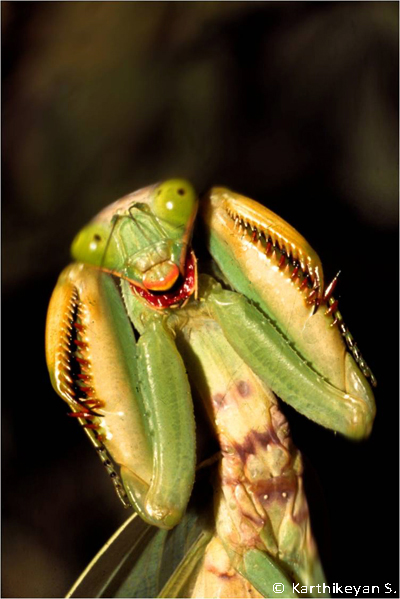
Raptorial forelegs with spines.
In the ensuing years, I have seen and photographed praying mantids several times. Each time, my fascination for these insects only has increased.
In more recent times, I saw a praying mantis in an arid country. This kept me rooted to one spot for a while. And, with good reason. This was a mantis that looked exactly like a dry twig and it sat amidst them too. As you will see, this stunning camouflage was just one of them.
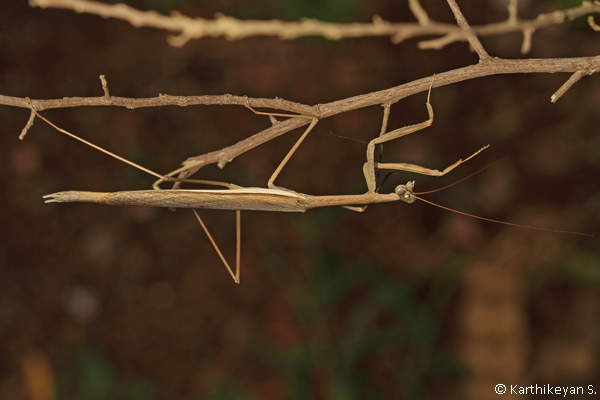
Stick-like praying mantis.
After I got some pictures of the whole creature, I had to get close. As I inched closer, I saw the mantis indulging in some toilet. It brought its fore legs up to its mouth and nibbled the entire length of it, cleaning the legs. This was the first time that I got to capture this behaviour. Both the legs were given this treatment. Not surprising, considering the importance of the legs for ‘preying’.
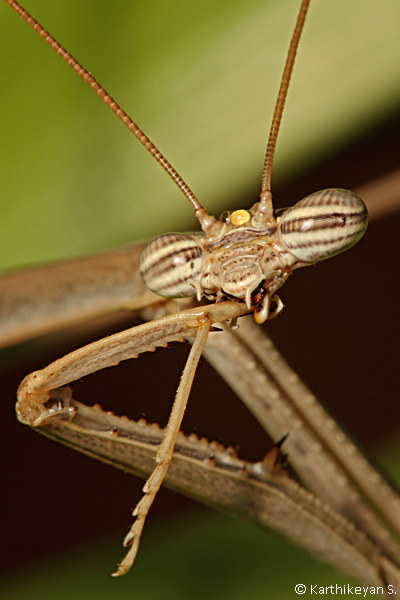
Praying Mantis cleaning its legs.
But more than anything else, it was the pair of compound eyes that kept me captivated. They were absolutely beautiful, what with brown and white lines running across. I had not seen anything like this in the past.
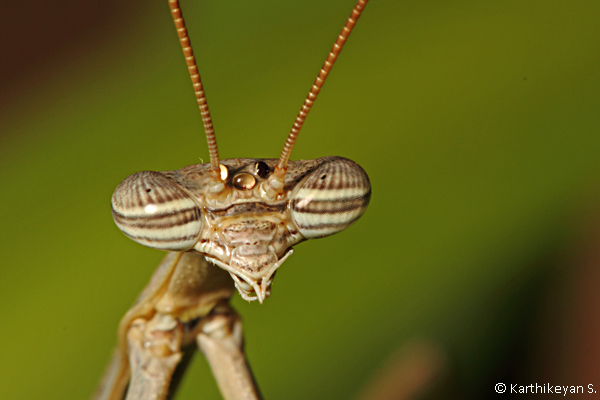
Close-up of the head of a praying mantis.
As I photographed the little beauty, I noticed (this time and many a times before) a black spot each on both the compound eyes. Not only that, the position of the spot changed as the insect moves its head or when I changed position. This gave the impression that the mantis is looking at me! These black spots had me intrigued time and again. However, this time I had resolved to find out more.
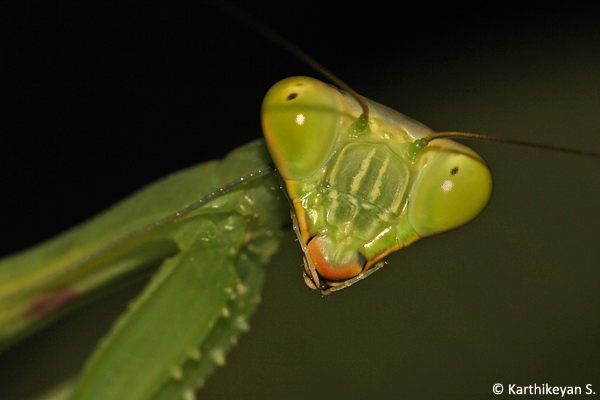
The black spots – pseudopupils of a praying mantis.
On my return home, I learnt that this black spot is called the pseudopupil. Each compound eye consists of several simple eyes (ommatidia) and only that simple eye that is on the same axis as that of the observer appears black. This explains why the black spot tends to move! So, should we say that the mantis looks you in the eye?!?!
Over the years, I have been lucky to witness, learn and appreciate various aspects of the life of a praying mantis – one of them being the way they reproduce. A female mantis lays a few hundred eggs; the number varies depending on the species. But what is of greater interest is the egg case that mantids make. The eggs are enclosed in a protective outer case. To begin with the female produces a frothy substance that is soft; it eventually hardens giving the eggs within, protection from various external factors. When the young (nymph) emerge, they hang by a silken thread before dispersing, like spiders do. This may be an adaptation to prevent being eaten by one of the siblings! It is the only time in their lives are they able to produce silk.
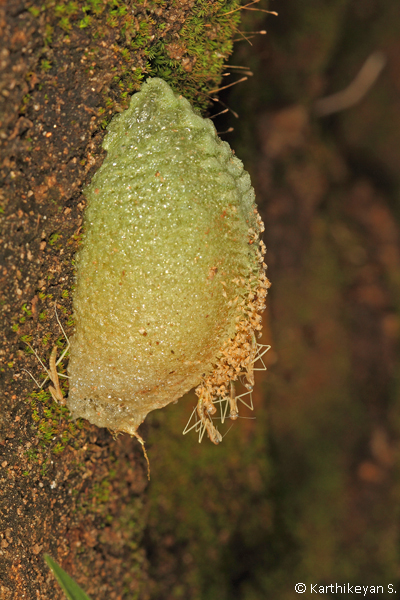
Young praying mantis emerging from the ootheca.
Eventually they move away from the egg case to fend for themselves. They are hunters from the very early stages and they will go about finding small insects and other creatures to prey upon.
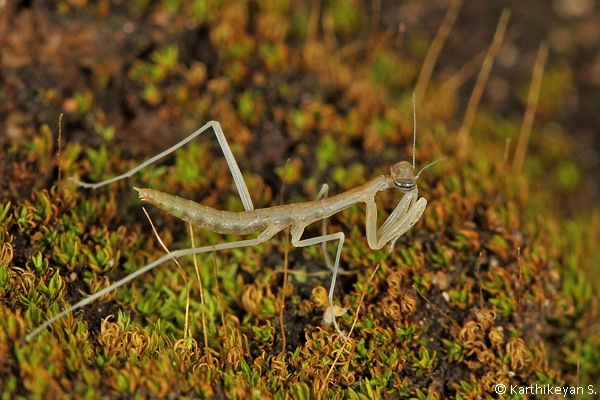
A just-emerged praying mantis nymph.
They lack wings as nymphs. They moult several times and each time they do so, they grow a little bit of their wing. It is only after the wings are fully grown that a mantis can fly! Until such time they can be seen running about in the vegetation trying to find prey.
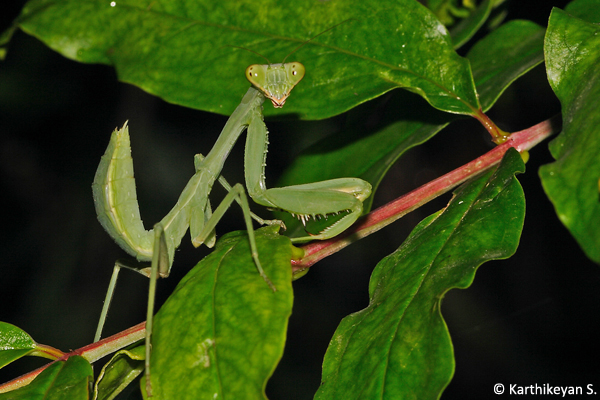
Praying mantis nymph.
Praying mantids are truly wonderful creatures and very well adapted to a predatory life style. They also have evolved several strategies to camouflage themselves in their environment – this helps them to hide from their predators and also to go unnoticed by their prey as the latter wander close to the mantis providing for easy pickings.
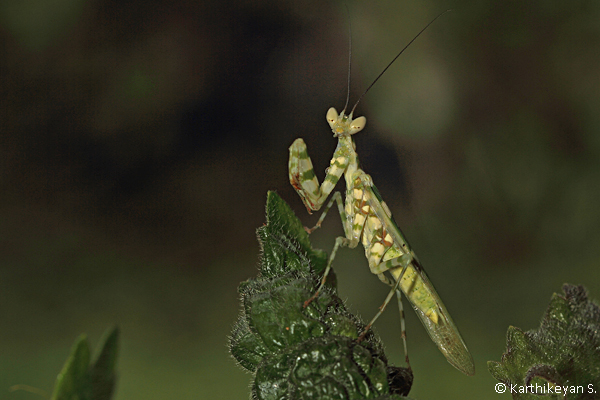
An adult praying mantis.
Every aspect of a praying mantis is fascinating and admirable. Be it their gluttonous appetite, their ability to turn their head following any movement, their predatory skills, the egg case they produce and many more… all hidden behind their saintly praying posture.
The next time you find a mantis, do enjoy your own mantis time – perhaps stare it in the eye!
Related stories :